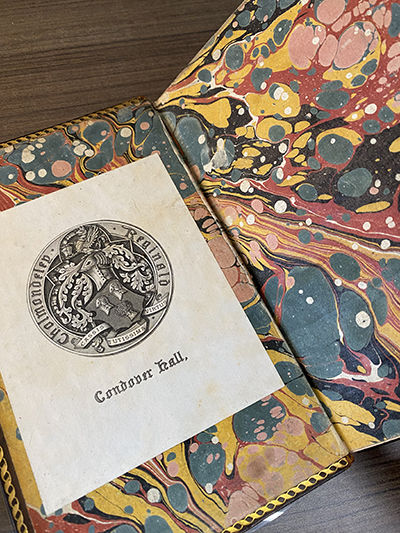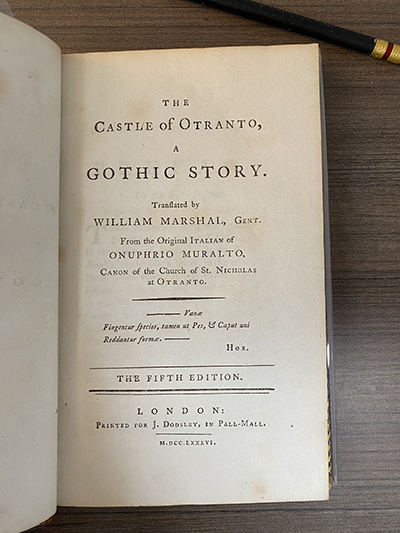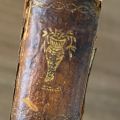During the Spring 2023 semester, Special Collections & Archives collaborated with Dr. Colleen Tripp's English 630, "Modern Monsters: Then & Now." Students in the class selected items from our collections of pulps, comics, and horror stories, then authored a series of blog posts in which they examined visual and other representations of the monstrous in the texts they chose. This is the fourth post of eight in the series.
The Castle of Otranto, published on Christmas Eve 1764, launched the Gothic novel genre. Horace Walpole initially issued the work under a pseudonym and claimed it was a translation of a found Italian medieval tale. However, after the novel was well received, Walpole revealed that he was the true author in the second edition published in 1765. He also added a subtitle, “A Gothic Story.” In the preface, Walpole stated the book was “an attempt to blend the two kinds of romance, the ancient and the modern.”1 Interestingly, when he disclosed that the work was fiction, critics denounced the text’s “absurd and monstrous fictions” and “preposterous phenomena,”2 demonstrating pushback toward a contemporary author who was spearheading a new genre.
The version of The Castle of Otranto in Special Collections & Archives is the fifth edition published in 1786. The book’s cover art is regal, featuring brown marbled leather with a gold chain border design imprinted around the edges. The spine has a black panel on which the title is imprinted in gold, beneath which there are five identical panels, each containing a golden amphora vase with a flower trailing leaves. The amphora motif suggests antiquity befitting the story’s medieval setting. Marbled endpaper in vibrant red, pink, white, yellow, and black tones on a green background embellishes the inside covers. The ornate detail of the art is suitable for this trailblazing text. The book presents as beautiful and luxurious, a book to be treasured.
The book has an inscription showing that it was a gift. It also contains a bookplate with the owner’s family crest. The crest features a family motto, “Cassis, Tutissima, Virtus,” Latin for “Virtue is the safest helmet.” This motto is particularly apropos as The Castle of Otranto opens with the revelation that an enormous helmet has inexplicably fallen on Prince Manfred’s fifteen-year-old son, Conrad, killing him on his birthday, which was also to have been his wedding day.
The Castle of Otranto is replete with elements associated with the Gothic. To start with, Conrad’s death is “[t]he first death—in all senses of the word—in Gothic fiction.”3 Next, the story is “set obscurely in the architecturally Gothic era of medieval churches and castles,” in Italy, creating an exotic tone of long ago and far away.4 With its underground passageways, hidden trap door and eerie sounds, the castle is an ideal setting for supernatural mystery and romance.
The Castle of Otranto also features a prophecy, another Gothic trope. In response to “the usurpation committed by [Manfred’s] grandfather,”5 it is foretold “[t]hat the castle and lordship of Otranto should pass from the present family, whenever the real owner should be grown too large to inhabit it.”6 Rumors about the cryptic prophecy overshadow life in the castle, despite Manfred’s protestations.
 After Conrad’s death, Manfred desperately attempts to escape his fate as dictated by the prophecy. He conceives a plan to divorce his loyal wife, Hippolita, and marry Conrad’s fiancée, Isabella, hoping to produce a male heir to replace Conrad. As he tells Isabella of his nefarious plan, one of Manfred’s ancestors, pictured in a portrait on the wall, sighs. This distraction provides Isabella an opportunity to escape, launching one of the Gothic’s most enduring tropes, the damsel in distress. Isabella is “Gothic fiction’s first trapped and hunted female victim, desperately seeking through gloomy subterranean passages . . . to evade the gross designs of her male aggressor.”7 Meanwhile, the ancestor steps down from the portrait frame and walks about the room. This magical occurrence presents “the shock of the supernatural” that often permeates the Gothic.8
After Conrad’s death, Manfred desperately attempts to escape his fate as dictated by the prophecy. He conceives a plan to divorce his loyal wife, Hippolita, and marry Conrad’s fiancée, Isabella, hoping to produce a male heir to replace Conrad. As he tells Isabella of his nefarious plan, one of Manfred’s ancestors, pictured in a portrait on the wall, sighs. This distraction provides Isabella an opportunity to escape, launching one of the Gothic’s most enduring tropes, the damsel in distress. Isabella is “Gothic fiction’s first trapped and hunted female victim, desperately seeking through gloomy subterranean passages . . . to evade the gross designs of her male aggressor.”7 Meanwhile, the ancestor steps down from the portrait frame and walks about the room. This magical occurrence presents “the shock of the supernatural” that often permeates the Gothic.8
The Castle of Otranto establishes a bountiful foundation for subsequent Gothic works. The prophecy is ultimately fulfilled, after giant appendages of Alfonso, the castle’s former rightful owner, appear, culminating in the utter collapse and disintegration of the castle and Alfonso’s magical ascension to the heavens accompanied by thunder. The now familiar chilling ethos of the Gothic abounds, as the “supernatural machinery” of the text “bears out the sense of an impending catastrophe all through the narrative.”9 Finally, thinking that he is exacting revenge on Isabella for refusing to marry him, Manfred mistakenly stabs and kills his daughter, Matilda, leaving him childless.
Walpole explains, in a preface, that “[t]error [is] the author’s principal engine” and “every thing tends directly to the catastrophe.”10 While remaining true to its moody and dark roots yet embracing newfound terrors, the Gothic continues to thrill and intrigue as a popular and significant cultural mode.11
1. Walpole, Horace. The Castle of Otranto. Project Gutenberg, 2010: 26.
2. Walpole, Horace. The Castle of Otranto, Gamer, Michael, editor. Edited by Michael Gamer, Appendix, Early Responses to The Castle of Otranto, “Review of The Castle of Otranto,” (2nd edition), Monthly Review 32 (May 1765), p. 397, Penguin Books, 2001: 234.
3. Farnell, Gary. “Gothic’s Death Drive.” Literature Compass, vol. 8, no. 9, 2011, pp. 592–608, https://doi.org/10.1111/j.1741-4113.2011.00823.x. 594.
4. Farnell, “Gothic’s Death Drive.” 600.
5. Wright, Angela and Dale Townshend, editors. The Cambridge History of the Gothic, Volume 1, Gothic in the Long Eighteenth Century, Chapter 1.5, “Horace Walpole and the Gothic,” Cambridge Univ. Press, 2020. 132.
6. Walpole, Horace. The Castle of Otranto. 34.
7. The Cambridge History. 132.
8. The Cambridge History. 133.
9. Farnell, “Gothic’s Death Drive.” 594.
10. Walpole, Horace. The Castle of Otranto. 10.
11. Tripp, Colleen. “Introduction to the Gothic” [lecture slides]. California State Univ. Northridge. Canvas. 35-36.








